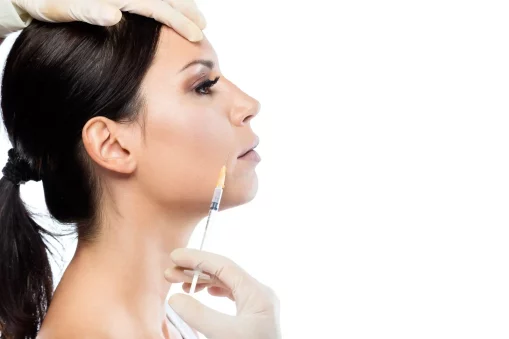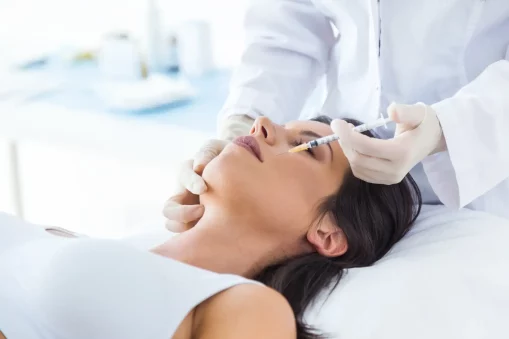We all want to age gracefully, yet certain facial features can give expression of sadness or fatigue.
Probably the most common cause of such appearance is marionette lines. These vertical creases, extending from the corners of the mouth to the chin, are among the first signs of aging that individuals seek to address.
While lifestyle factors like sun exposure, smoking, and genetics contribute to their formation, the primary culprit is natural aging, gradually reducing skin elasticity and volume.
Luckily, there is a solution. Botox is a non-invasive method to soften these lines and restore your look from 10 or 20 years ago.
Below, we will explore how Botox targets marionette lines, the benefits it offers, and what to expect during treatment.
Marionette Lines 101
Marionette lines are actually vertical creases extending from the corners of the mouth to the chin.
Common symptoms include a loss of jawline definition and a less defined chin area, which contribute to an older, tired look. Psychologically, marionette lines can negatively impact self-esteem and confidence, as they may cause individuals to appear older or unhappy than they actually are.
Key muscles for marionette lines include the depressor anguli oris (DAO), which is responsible for pulling the corners of the mouth downward. The platysma, a muscle extending from the chest and shoulder up to the chin, can also accentuate the drooping of the jawline as it loses tone.
As the skin ages, the underlying fat and supportive tissue diminish, exacerbating the appearance of these lines. On top of that, the weakening of the skin’s collagen and elastin fibers further reduces skin elasticity and firmness.
Marionette lines differ from other types of wrinkles as they are caused by a combination of muscle activity and skin sagging rather than repetitive facial expressions.
Botox: Mechanism and Benefits
Botox, derived from Clostridium botulinum, works by blocking the release of acetylcholine at the neuromuscular junction. This interruption prevents muscle contraction, leading to a temporary reduction in muscle activity.
In case of marionette lines — Botox relaxes the muscles responsible for pulling down the corners of the mouth. As we already explained, marionette lines are not created by repetitive facial expressions, so Botox reduces the downward pull. Thus, it fixes these lines.
The primary benefit of Botox for marionettes is the reduction of visible lines and the improvement of facial aesthetics.
Since patients do not have to undergo surgery, this belongs to the group of non-invasive procedures. The treatment is quick and requires minimal downtime, so you can still opt for it even if you are busy.
And if patients don’t like the results, they last between 3 to 6 months, so it’s not irreversible.
The Botox Treatment Process
Everything starts with the initial assessment or even a few consultations. Then, a treatment plan is made, which includes a review of the patient’s medical history, such as pre-existing conditions, allergies, or medications that might affect the treatment.
Next, a facial analysis must be carried out. The practitioner examines the severity and depth of the marionette lines and evaluates the patient’s facial anatomy.
The Botox injection process is straightforward and minimally invasive. The procedure begins with preparing the treatment area. The practitioner cleanses the skin and applies topical anesthetic.
Once the skin is prepared, the practitioner uses a fine needle to administer Botox into the targeted muscles that form marionette lines. The procedure typically takes between 15 and 30 minutes, depending on the size of the treatment area and the number of
injections required. This quick treatment time makes Botox an ideal “lunchtime procedure.”
Most patients experience minimal discomfort, often described as a slight pinch or pressure. After the procedure, there is no required downtime. Still, patients are usually advised to avoid strenuous activities and to keep their heads elevated for a few hours to prevent the spread of Botox to unintended areas.
Comparing Botox with Other Treatment Options
Botox reduces muscle-related lines, and dermal fillers address volume loss and skin laxity.
Dermal fillers, most often hyaluronic acid, are injected substances that restore volume to the treated areas. Fillers can last 6 to 18 months, offering a longer-lasting solution than Botox. However, they do not address muscle activity.
Surgical options, like facelifts, offer a more permanent solution for marionette lines but involve greater risk and recovery time. Every surgery is invasive, with significant downtime and potential complications.
Combining Botox with other treatments is the best option for comprehensive facial rejuvenation. Laser therapy is often used alongside Botox to improve skin texture and tone, while chemical peels exfoliate the skin.
Risks and Side Effects of Botox
Botox is widely considered one of the safest substances. Nevertheless, like any medical procedure, it can have side effects. Most are minor and temporary, disappearing on their own within a few days.
The most common side effects include:
- Bruising and Swelling: The needle penetrates the skin, causing those two side effects. Using a cold compress after the procedure can help.
- Redness and irritation: Some patients may notice slight redness or irritation at the injection site, which usually fades within a few hours. Mild Headaches: A small percentage of patients experience headaches. Over-the-counter pain relief is effective in stopping such headaches.
- Localized Pain or Tenderness: Slight tenderness or discomfort at the injection sites is expected during the first 48 hours.
- Temporary Drooping of the Mouth Corners: Rarely, Botox can cause temporary drooping or asymmetry in the treated area. This occurs if the Botox migrates to adjacent muscles. Fortunately, this effect is usually correctable with follow-up treatments and dissipates as the Botox naturally wears off.
Rare Side Effects
While severe complications from Botox are rare, they can occur, especially if the procedure is not performed by an experienced practitioner.
Some of the more serious risks are:
- Infection: Although Botox injections are minimally invasive, there is still a risk of infection at the injection site. This risk is minimized through proper sterilization techniques and adherence to strict hygiene protocols.
- Allergic Reactions: Symptoms of an allergic reaction are rash, itching, shortness of breath, or swelling of the face and throat. Immediate medical attention is necessary.
- Vision Problems: Botox injections near the eyes have been reported to cause blurred vision or drooping eyelids.
- Difficulty Swallowing or Breathing: When Botox is used in higher doses or improperly administered, it can spread to areas that control essential functions. This is a medical emergency.
- Muscle Weakness Beyond the Injection Site: If Botox spreads from the injection site, it can cause muscle weakness in other areas, which is temporary but scares patients.
Long-term Effects and Maintenance
While most people can expect Botox to be effective for three to six months, those with a faster metabolism may notice a shorter duration. Also, individuals who lead a healthy lifestyle, such as exercising and eating well, may enjoy prolonged results.
Consistent treatment helps maintain muscle relaxation and line reduction, making follow-up treatments necessary.
In Summary
Botox is a highly effective, non-surgical solution for treating marionette lines.
The treatment leads to immediate improvements, and you don’t have to miss days at your job because recovery is fast.
Also, Botox is versatile. It can be combined with other cosmetic treatments, like dermal fillers and laser therapy, to get even better results. That way, you can address multiple signs of aging simultaneously.
Before getting Botox treatment, you must consult a qualified practitioner to avoid unrealistic expectations, understand potential side effects, and receive a personalized treatment plan.
Frequently Asked Questions (FAQ)
What are the latest advances in Botox technology for treating marionette lines?
Recent advances in Botox technology include precision-targeting techniques and the development of novel formulations that offer longer-lasting results. Research is ongoing to enhance the duration of Botox’s effects, potentially extending its impact beyond the typical 3-6 months. New injection techniques (micro-Botox) involve using smaller doses with greater precision, minimizing side effects, and improving outcomes.
Are there any long-term risks associated with repeated Botox treatments for marionette lines?
When performed by qualified practitioners, the long-term risks associated with repeated Botox treatments for marionette lines are minimal. However, some patients may experience muscle weakening over time, potentially leading to changes in facial expression.
Rarely, prolonged use results in antibody development, reducing treatment efficacy.
What is the role of a patient’s skin type in determining the effectiveness of Botox for marionette lines?
A patient’s skin type plays a crucial role in determining the effectiveness of Botox. Thicker, more resilient skin usually requires higher doses or additional treatments. On the other hand, thinner skin responds more quickly. Yet, it can be prone to bruising or uneven results if not treated carefully.
How to approach Botox treatment for marionette lines in younger vs. older patients?
The difference in Botox treatment for marionette lines between younger and older patients lies in the approach and goals. Younger patients seek Botox as a preventive measure, trying to delay the onset of deeper lines. In contrast, older patients typically require a more corrective approach, addressing established wrinkles and volume loss.
What is the impact of hormonal changes on the formation of marionette lines and the efficacy of Botox treatment?
Hormonal changes, especially those associated with aging, can accelerate the formation of marionette lines. Such hormonal changes affect skin elasticity and collagen production. Decreased estrogen levels, for example, lead to thinner, less resilient skin, making it more susceptible to wrinkles. Botox remains effective despite hormonal changes, as it targets muscle activity rather than skin structure.
References
Mess SA. Lower Face Rejuvenation with Injections: Botox, Juvederm, and Kybella for Marionette Lines and Jowls. Plast Reconstr Surg Glob Open. 2017 Nov 9;5(11):e1551. doi: 10.1097/GOX.0000000000001551. PMID: 29263958; PMCID: PMC5732664.
Hong GW, Kim SB, Park SY, Wan J, Yi KH. Why do marionette lines appear? Exploring the anatomical perspectives and role of thread-based interventions. Skin Res Technol. 2024 Apr;30(4):e13676. doi: 10.1111/srt.13676. PMID: 38572585; PMCID: PMC10993050.



0 Comments